|
| Division: Cycadophyta |
| Class: Cycadopsida |
| Order: Cycadales |
| Family: Zamiaceae |
| Genus: Encephalartos |
| Species: E. humilis |
Conservation Status: |

E. humilis
Dwarf CycadEncephalartos humilis (Latin humilis, humble or lowly), is a dwarf species with very little clear trunk and short, keeled, twisted and recurved leaves with entire leaflets. This species grows in subalpine grassland, on slopes on sandy soils over sandstones and are often wedged between sandstone rocks.
Populations are mostly found on east and northeast facing slopes. Heavy rains and dense mists favour coning. This species is threatened by the lack of natural fires in vast managed plantations and this possibly suppresses coning frequency.
The plant is acaulescent; its stem 0.3 m tall and 20 cm in diameter. The leaves are 30-50 cm long, dark green, semiglossy and slightly keeled (opposing leaflets inserted at 120-160° on rachis). The rachis is yellowish, straight with last third sharply recurved, slightly twisted in some leaves; petiole straight, with no prickles. The leaf-base collar is not present and basal leaflets are not reducing to spines. Leaflets are linear, strongly discolorous, not overlapping and not lobed, insertion angle obtuse (45-80°). The margins are flat, upper margin entire (no teeth), lower margin entire (no teeth), and median leaflets are 9-13 cm long and 4-6 mm wide.
Pollen cones 1, narrowly ovoid, brown, 15-20 cm long, 4-5 cm diameter. Seed cones 1, ovoid, brown, 25-30 cm long, 8-10 cm diameter. Seeds ovoid, 25-30 mm long, 20-25 mm wide, sarcotesta yellow.
Cultivation:
E. humilis does not cone easily and only produces one cone per stem. It also does not transplant readily. The plants are in serious danger of becoming totally extinct.
| full sun | blue-green | low watering | slow growth | frost-hardy | rare |
E. humilis does not cone easily and only produces one cone per stem. It also does not transplant readily. The plants are in serious danger of becoming totally extinct.
E. humilis for sale at AfricaCycads.com:
